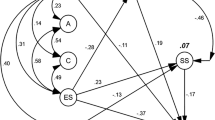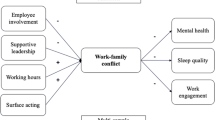Abstract
One of the key factors for promoting well-being lies in balancing one’s daily life occupations and the nature of these occupations. Occupation refers to a group of everyday life goal-directed activities which may be associated to any life domain, not necessarily work, such as leisure, education, or self-care. Yet it is not clear what constitutes occupational imbalance, and its association to other factors has not been examined systematically. This study proposed and tested a theoretical model for specifying the structural relationships between occupational imbalance, occupational characteristics, personality and well-being. 288 working adults completed the following questionnaires: Inter-goal Relations Questionnaire (occupational imbalance), Personal Projects Analysis (occupational characteristics), the Big Five Inventory (personality traits) and the Satisfaction with Life Scale (well-being). Twenty-five models were tested using structural equation modeling. All the models fit the data well. Occupational characteristics, with the exception of stress, served as significant mediators between personality and well-being, yet occupational imbalance did not play a significant role across all models. Our findings provide substantial support for the importance of occupation to well-being, however occupational imbalance is still an elusive concept that requires further investigation theoretically and empirically.


Similar content being viewed by others
References
Anaby, D. Jarus, T., & Zumbo, B. (2010). Psychometric evaluation of the Hebrew language version of the Satisfaction with Life Scale. Social Indicators Research, 96, 267–274.
AOTA. (2002). Occupational therapy practice framework: domain and process. American Journal of Occupational Therapy, 56, 609–639.
Arrindell, W. A., Meeuwesen, L., & Huyse, F. J. (1991). The satisfaction with life scale (SWLS)—psychometric properties in a nonpsychiatric medical outpatients sample. Personality and Individual Differences, 12, 117–123.
Backman, C. (2001). Occupational balance: Measuring time use and satisfaction across occupational performance areas. In M. Law, C. Baum, & W. Dunn (Eds.), Measuring occupational performance: Supporting best practice in occupational therapy (pp. 203–213). Thorofare: Slack.
Backman, C. L. (2004). Occupational balance: exploring the relationships among daily occupations and their influence on well-being. Canadian Journal of Occupational Therapy, 71, 202–209.
Bentler, P. M. (1985). Theory and implication of EQS: A structural equations program. Los Angeles: BMDP Statistical Software.
Bentler, P. M. (1995). EQS structural equations programs manual. Enrico: Multivariate Software, Inc.
Bentler, P. M., & Chou, C. P. (1987). Practical issues in structural modeling. Sociological Methods & Research, 16, 78–117.
Bollen, K. A., & Long, J. S. (1993). Testing structural equation models. Newburyk Park: Sage.
Byrne, B. M. (2006). Structural equation modeling with EQS: Basic concepts, applications, and programming (2nd ed.). Mahwah: Erlbaum.
Canadian Association of Occupational Therapists. (1997). Enabling occupation: An occupational therapy perspective. Ottawa: Canadian Association of Occupational Therapists.
Christiansen, C. H. (1996). Three perspectives on balance in occupation. In R. Zemke & F. Clark (Eds.), Occupational science: The evolving discipline (pp. 431–451). Philadelphia: F.A. Davis.
Christiansen, C. (2000). Identity, personal projects and happiness: self construction in everyday action. Journal of Occupational Science, 7, 98–107.
Christiansen, H. C., & Baum, M. C. (2005). Humans as occupational beings (understanding human occupation). Occupational therapy: Performance, participation, and well-being (3rd ed., pp. 2–22). Thorofare, NJ: Slack.
Christiansen, C. H., & Matuska, K. M. (2006). Lifestyle balance: a review of concepts and research. Journal of Occupational Science, 13, 49–61.
Christiansen, C. H., Backman, C., Little, B. R., & Nguyen, A. (1999). Occupations and well-being: a study of personal projects. American Journal of Occupational Therapy, 53, 91–100.
Clark, F., Azen, S. P., Zemke, R., Jackson, J., Carlson, M., Mandel, D., et al. (1997). Occupational therapy for independent-living older adults: a randomized controlled trial. JAMA: Journal of the American Medical Association, 278, 1321–1326.
Csikszentmihalyi, M. (1997). Finding flow: The psychology of engagement with everyday life (1st ed.). New York: BasicBooks.
Csikszentmihalyi, M., & Hunter, J. (2003). Happiness in everyday life: the uses of experience sampling. Journal of Happiness Studies, 4, 185–199.
Cummins, R. A., Lau, A. D. L., & Davern, M. (in press). Homeostatic mechanisms and the quality of life. In K. C. Land (Ed.), Handbook of social indicators and quality of life studies. Theoretical and methodological foundation. New York: Springer.
DeNeve, K. M., & Cooper, H. (1998). The happy personality: a meta-analysis of 137 personality traits and subjective well-being. Psychological Bulletin, 124, 197–229.
Diener, E., Emmons, R. A., Larsen, R. J., & Griffin, S. (1985). The satisfaction with life scale. Journal of Personality Assessment, 49, 71–75.
Diener, E., Suh, E. M., Lucas, R. E., & Smith, H. L. (1999). Subjective well-being: three decades of progress. Psychological Bulletin, 125, 276–302.
Diener, E. (1984). Subjective well-being. Psychological Bulletin, 95, 542–575.
Furnham, A. (1981). Personality and activity preference. British Journal of Social Psychology, 20, 57–68.
Håkansson, C., Dahlin-lvanoff, S., & Sonn, U. (2006). Achieving balance in everyday life. Journal of Occupational Science, 13, 74–82.
Hu, L., & Bentler, P. M. (1999). Cutoff criteria for fit indexes in covariance structure analysis: conventional criteria versus new alternatives. Structural Equation Modeling, 6, 1–55.
Jöreskog, K., & Sörbom, D. (1993). LISREL 8 user’s reference guide. Chicago: Scientific Software International.
John, O. P., & Srivastava, S. (1999). In L. A. Pervin & O. P. John (Eds.), The big five trait taxonomy: History, measurement, and theoretical perspectives. New York: Guilford.
Jonsson, H., & Persson, D. (2006). Towards an experiential model of occupational balance: an alternative perspective on flow theory analysis. Journal of Occupational Science, 13, 62–73.
Karasek, R., & Theorell, T. (1990). Healthy work: Stress, productivity, and the reconstruction of working life. New York: Basic Books.
Law, M., Cooper, B. A., Strong, S., Stewart, D., Rigby, P., & Letts, L. (1996). The person-environment-occupational model: a transactive approach to occupational performance. Canadian Journal of Occupational Therapy, 63, 9–23.
Lawrence, R. J. (2006). Housing and health: beyond disciplinary confinement. Journal of Urban Health-Bulletin of the New York Academy of Medicine, 83, 540–549.
Lecci, L., Karoly, P., Briggs, C., & Kuhn, K. (1994). Specificity and generality of motivational components in depression—a personal projects analysis. Journal of Abnormal Psychology, 103, 404–408.
Little, B. R. (1983). Personal projects—a rationale and method for investigation. Environment and Behavior, 15, 273–309.
Little, B. R. (1984). Personal projects analysis—a methodology for the moral science of action. Bulletin of the British Psychological Society, 37, A115–A115.
Little, B. R. (1996). Free traits, personal projects and idio-tapes: three tiers for personality psychology. Psychological Inquiry, 7, 340–344.
Little, B. R. (1999). Personality and motivation: Personal action and the conative evolution. In L. A. Pervin & O. P. John (Eds.), Handbook of personality: Theory and research (2nd ed., pp. 501–524). New York: Guilford.
Little, B. R. (2007). Prompt and circumstance: The generative contexts of personal project analysis. In B. R. Little, K. Salmela-Aro, & S. D. Phillips (Eds.), Personal project pursuit: Goals, action, and human flourishing (pp. 3–49). Mahwah: Erlbaum.
Little, B. R., & Chambers, N. C. (2004). Personal project pursuit: On human doings and well-beings. In W. M. Cox, E. Klinger, W. M. Cox, & E. Klinger (Eds.), Handbook of motivational counseling: Concepts, approaches, and assessment (pp. 65–82). New York: Wiley.
Little, B. R., Lecci, L., & Watkinson, B. (1992). Personality and personal projects: linking big five and PAC units of analysis. Journal of Personality, 60, 501–525.
Marks, S. R. (2009). Multiple roles and life balance: An intellectual journey. In K. M. Matuska, C. H. Christiansen, J. Davis, & H. Polatajko (Eds.), Life balance: Multidisciplinary theories and research (pp. 43–58). Bethesda: AOTA.
McColl, M. A., Law, M., & Stewart, D. (1993). Theoretical basis of occupational therapy: An annotated bibliography of applied theory in the professional literature. Thorofare: SLACK.
McDonald, A. R., & Seifert, F. C. (1999). Full and limited information strategies for incorporating measurement error in regression models. Atlanta, GA. Paper presented at the Southern Management Association Meeting.
McGregor, I., & Little, B. R. (1998). Personal projects, happiness, and meaning: on doing well and being yourself. Journal of Personality and Social Psychology, 74, 494–512.
Meyer, A. (1977). Philosophy of occupation therapy. American Journal of Occupational Therapy, 31, 639–642.
Omodei, M. M., & Wearing, A. J. (1990). Need satisfaction and involvement in personal projects—toward an integrative model of subjective well-being. Journal of Personality and Social Psychology, 59, 762–769.
Palys, T. S., & Little, B. R. (1983). Perceived life satisfaction and the organization of personal project systems. Journal of Personality and Social Psychology, 44, 1221–1230.
Pat-Horenczyk, R. (2006). Terror in Jerusalem: Israelis coping with ‘emergency routine’ in daily life. In J. Kuriansky & J. Kuriansky (Eds.), Terror in the holy land: Inside the anguish of the Israeli-Palestinian conflict (pp. 67–74). Westport: Praeger Publishers/Greenwood Publishing Group.
Pavot, W., & Diener, E. (1993). Review of the satisfaction with life scale. Psychological Assessment, 5, 164–172.
Pentland, W., & McColl, M. A. (2008). Occupational integrity: another perspective on “life balance”. Canadian Journal of Occupational Therapy, 75, 135–138.
Reilly, M. (1966). Psychiatric occupational therapy program as a teaching model. American Journal of Occupational Therapy, 20, 61–67.
Renwick, R., Brown, I., & Nagler, M. (1996). Quality of life in health promotion and rehabilitation: Conceptual approaches, issues, and applications. Thousand Oaks: SAGE.
Riediger, M. (2007). Interference and facilitation among personal goals: Age differences and associations with well-being and behavior. In B. R. Little, K. Salmela-Aro, & S. D. Phillips (Eds.), Personal project pursuit: Goals, action, and human flourishing (pp. 119–143). Mahwah: Erlbaum.
Riediger, M., & Freund, A. M. (2004). Interference and facilitation among personal goals: differential associations with subjective well-being and persistent goal pursuit. Personality and Social Psychology Bulletin, 30, 1511–1523.
Riediger, M., Freund, A. M., & Baltes, P. B. (2005). Managing life through personal goals: intergoal facilitation and intensity of goal pursuit in younger and older adulthood. Journals of Gerontology Series B-Psychological Sciences and Social Sciences, 60, P84–P91.
Salmela-Aro, K., & Little, B. R. (2007). Relational aspects of projects pursuits. In B. R. Little, K. Salmela-Aro, & S. D. Phillips (Eds.), Personal project pursuit: Goals, action, and human flourishing (pp. 199–219). Mahwah: Erlbaum.
Vassar, M. (2008). A note on the score reliability for the satisfaction with life scale: an RG study. Social Indicators Research, 86, 47–57.
Wallenius, M. (1999). Personal projects in everyday places: perceived supportiveness of the environment and psychological well-being. Journal of Environmental Psychology, 19, 131–143.
Wallenius, M. (2000). Personal project level of abstraction and project conflict: relations to psychological well-being. European Journal of Personality, 14, 171–184.
Wallenius, M. A. (2007). Personal project content and stress: relations to subjective health and depressive mood. Social Indicators Research, 81, 35–50.
Watson, D., & Clark, L. A. (1997). Extraversion and its positive emotional core. In R. Hogan, J. A. Johnson, & S. R. Briggs (Eds.), Handbook of personality psychology (pp. 767–793). San Diego: Academic.
Wenzel, M. U. (2000). Goal striving among cardiac patients: a constructivist investigation of mood and rehabilitation enrollment. ProQuest Information & Learning. Dissertation Abstracts International: Section B: The Sciences and Engineering, 61, 2229.
Westhorp, P. (2003). Exploring balance as a concept in occupational science. Journal of Occupational Science, 10, 99–106.
WHO. (2001). International classification of functioning, disability and health. Geneva: WHO.
Wilcock, A. A. (1998). An occupational perspective of health. Thorofare: SLACK, Inc.
Wilcock, A. A., Chelin, M., Hall, M., Hamley, N., Morrison, B., Scrivener, L., et al. (1997). The relationship between occupational balance and health: a pilot study. Occupational Therapy International, 4, 17–30.
Yerxa, E. J., Clark, F., Frank, G., Jackson, J., Parham, D., Pierce, D., et al. (1989). An introduction to occupational science, a foundation for occupational therapy in the 21st century. Occupational Therapy in Health Care, 6, 1–17.
Yetim, U. (1993). Life satisfaction—a study based on the organization of personal projects. Social Indicators Research, 29, 277–289.
Zuzanek, J. (1998). Time use, time pressure, personal stress, mental health, and life satisfaction from a life cycle perspective. Journal of Occupational Science, 5, 26–39.
Author information
Authors and Affiliations
Corresponding author
Rights and permissions
About this article
Cite this article
Anaby, D., Jarus, T., Backman, C.L. et al. The Role of Occupational Characteristics and Occupational Imbalance in Explaining Well-being. Applied Research Quality Life 5, 81–104 (2010). https://doi.org/10.1007/s11482-010-9094-6
Received:
Accepted:
Published:
Issue Date:
DOI: https://doi.org/10.1007/s11482-010-9094-6




